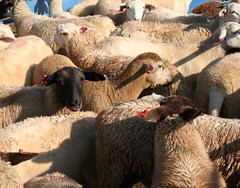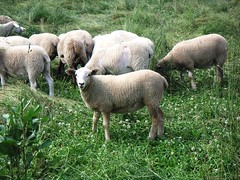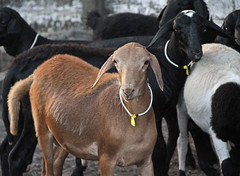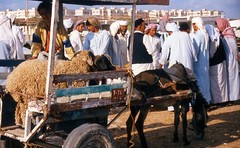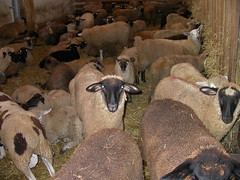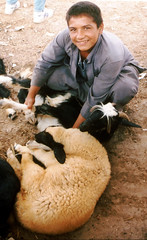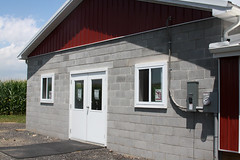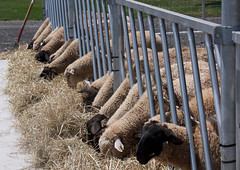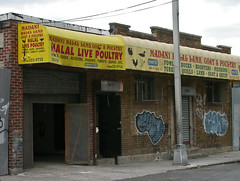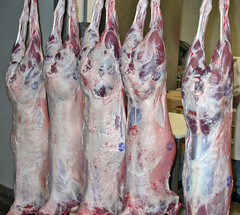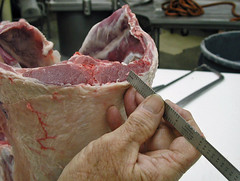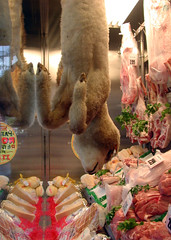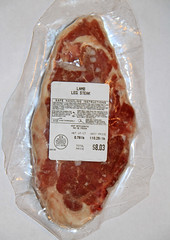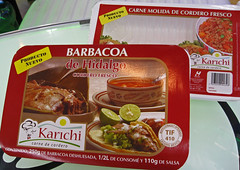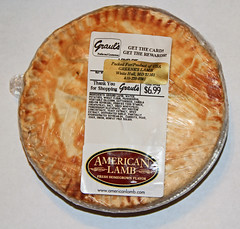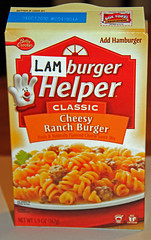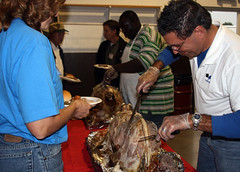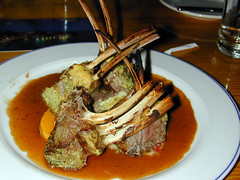- Sheep 201 Index
- Other web sites
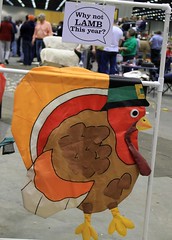
Why not lamb?

Wholesale lamb

Meaty market lambs

San Angelo Stockyards

Lamb chops
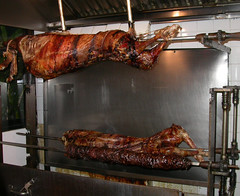
Whole lamb carcasses on a split
Lamb Marketing
Most sheep operations derive the majority of their income from the sale of lambs or meat. As a result, lamb prices have a large influence on profitability and viability of the sheep enterprise. There are numerous options for marketing lambs and pros and cons to each one. When comparing marketing options, it is important to compare "net" prices, as different marketing options have different costs associated with them.
The Basics
Lamb vs. mutton
Lamb is the meat from a sheep that is less than one year of age. Mutton is the meat from a sheep that is older than one year. Yearling mutton comes from a sheep between 1 and 2 years of age. Mutton has a more intense flavor than lamb and is usually less preferred by most consumers.In a live animal, age can be determined by examining the front teeth ( incisors). A lamb has eight milk teeth on its lower jaw, whereas a yearling has cut its first pair of permanent incisor teeth, and a sheep has cut its second pair. In the carcass, age is determined by the presence or absence of a spool or break joint. The break joint is a cartilaginous area of the cannon bone that is not ossified (bony). This joint ossifies with age to become what is called a spool joint.
A lamb carcass has two break joints on the front shanks. The joints are red, moist, and porous. The ribs of a lamb carcass vary in shape and have some redness on the exposed surfaces. A mutton carcass has two spool joints. The ribs are wide, flat, and the color of mature bone. A yearling carcass usually has at least one spool joint. Because age is an important factor that determines the value of an ovine carcass, efforts continue to define lamb"maturity."
Demand for lamb
In the United States, the demand for lamb has been declining for decades. The current per capita consumption is less than one-half pound per person per year. One about half the US population had tried lamb. Lamb is a specialty product in US grocery stores. It accounts for less than percnet of meat sales. At the same time, the US does not produce enough sheep meat to meet consumer demand. Imports, mostly from Australia and New Zealand, usually comprise more than 50 percent of domestic consumption.Men are more likely to eat lamb than women. Traditional immigrants of northern European descent generally do not consume much lamb; however, lamb holds a significant meaning in the observances of many religions and is a dietary staple in many parts of the world. Newer immigrants are more likely to consume lamb.
Lamb is the preferred meat for many Christian, Jewish, and Muslim holidays. In the US, the primary consumers of lamb are Middle Easterners (primarily Muslims), Orthodox Christians (Greeks, Italians, and Ethiopians), Jews, and Hispanics. Most lamb is consumed on the East and West Coasts and in major metropolitan areas where large ethnic populations exist.
Lamb grading standards
Carcass
Lamb quality and yield grade standards have been in existence for many years. Quality grades denote the palatability and eating characteristics of meat. USDA lamb grades are Prime, Choice, Good, and Utility. From 2012- 2016, more than 99 percent of lambs graded Choice or Prime. Fatter lambs are more likely to grade Prime. In the ethnic markets, there is a preference for lighter, leaner lambs. Many of these lambs would fail to grade choice. In other cases, they would not even be quality graded.
Yield grade standards estimate the percentage of closely trimmed, boneless retail cuts from the leg, loin, rib, and shoulder. They are based primarily on the amount of external fat in the carcass. The grades are 1, 2, 3, 4, and 5, with 1 being the leanest and 5 being the fattest. From 2012-2016, approximately 75 percent of lambs yield graded graded 2 or 3. In the commodity market, yield grade 1s, 4s, and 5s are usually discriminated in price. 4s and 5s are too fat and heavy, while 1s lack sufficient fat cover and quality.
Live
USDA grades for live lambs are the same as carcass grades. Because so many lambs grade Choice, some states (e.g. Virginia and West Virginia) have split the Choice grade into two grades. A Blue-O or Blue (Back) lamb is a Prime or high Choice lamb that is expected to have a higher dressing percentage than a Red-O or Red (Back) lamb.
Some states in the Northeast (e.g. New York) have modified the USDA grading standards to better fit the needs of the ethnic markets. Lambs are graded as Blue, Red, or Green, regardless of weight. Blue lambs are fatter and thicker than red lambs. Green lambs are thin and/or in poor body condition; they are not considered market ready.
Feeder lambs
Feeder lambs are lighter-weight lambs (usually 60 to 90 lbs.) that are usually sold to feed lots or grazers for further finishing. They are sold according to weight and frame size, e.g. large, medium, and small. Some states have devised their own grading standards for feeder lambs, primarily separating lambs by weight.
Feeder lamb grades have become less important, as almost any lamb is now deemed a potential slaughter lamb, regardless of weight or condition. Lambs traditionally fed to heavier finish weights are now sometimes bought by "ethnic" slaughterhouses, which prefer leaner, lighter weight lambs for slaughter.
Grading can be very useful aspact of lamb marketing. It provides a uniform description of livestock. It allows livestock to be co-mingled at the market place. It provides a uniform means to report prices. With grades and other descriptors, you should be able to compare prices of lambs sold in any part of the US. Direct marketers can use prices of graded lambs to help them determine the value of their lambs.
View the USDA market report (weighed average) from New Holland, PA =>
Age, weight, and sex
The age and weight at which lambs are harvested for meat varies. Slaughter weights vary from a 30-lb. hot house lamb to a 200-lb. extra-heavy commodity lamb. While the average weight of a lamb slaughtered under federal inspection (in the US). is about 135 pounds, the ethnic markets tend to prefer lighter weight lambs.
Lambs are usually marketed between the ages of 2 and 15 months. Two-month old lambs are sold as hot house lambs, whereas some feed lot lambs still have their milk teeth and spool joints at 14 to 15 months of age. A hot house lamb is a milk-fed lamb that is usually born out-of-season (fall or early winter) and raised indoors. Hot house lambs are a delicacy favored by Orthodox Christians, especially at the Easter and Christmas holidays.
Consumers generally show no significant preference for meat from wether, ewe, or ram lambs, though some consumers may note an off-flavor with the meat from ram carcasses. Ram lambs are leaner and gain faster than ewe and wether lambs, but some (commodity) markets may discount intact ram lambs. Conversely, some ethnic markets have a preference for intact males and other unblemished lambs. A potential alternative to ram lambs is short-shortum lambs; rams whose testicles are pushed up inside their body cavity before banding of the scrotal sack. Short-scrotum rams have similar growth rates as intact males, without some the undesirable characteristics.
Shrink (drift)
Shrink is an important component of lamb marketing. Shrink is the amount of weight that a lamb loses during transport to market. Shrink is mostly loss of stomach contents or “gut fill” during the first 20 hours off-feed. After the first 20 hours, the lamb’s body compensates for restricted water and feed intake by drawing moisture and nutrients from carcass tissue.
Shrink due to trucking is highest in the first 50 to 75 miles. Length of transport increases the amount of shrink. Lambs lose more weight in hot weather than cold weather. Lambs consuming grass or forage diets will shrink more than those consuming concentrate diets. Young lambs shrink more than older lambs. Five to 8 month old lambs usually shrink five percent or more from farm to market weight.Management practices can affect shrink. According to research, lambs that are sorted and comingled the night before selling will shrink more than those that are sorted the day of sale. Lambs that are taken off feed and fed hay the night before will shrink more than lambs that are left on their same feed ration. In order to minimize shrink loss, it is better to keep lambs on the same diet the night before selling.
Some buyers will apply a "pencil shrink" to lambs: 3 to 4 percent of the scale weight will be deducted from the lamb. When lambs are sold on the rail, shrink is not important, as gut fill is removed before the carcass is weighed. When making marketing decisions, shrink needs to be considered as a cost.
Marketing options
According to a recently-revised study (2020), the US lamb market divides into two halves: commodity lambs and non-traditional markets (ethnic and direct-to-consumer). Lamb marketing options fit into two broad categories: commodity and direct (to the consumer). Many of the lambs destined for the ethnic markets are channeled through similar commodity markets, as the big commodity lambs that to into food service and retail.
Commodity marketing
Regardless of geographic location, the vast majority of lambs are sold into some sort of commodity market. This would include selling lambs at a public livestock auction; to an order buyer, broker, or dealer; through a buying station; to a feed lot; through a co-op or marketing pool, or to an abattoir. In a commodity market, you are selling a bulk, generic product. Identity is generally lost in the marketing process.
Commodity marketing favors large commercial and low-cost producers and those in close proximity to terminal markets. A terminal market is one in which lambs are bought for immediate slaughter. At many other sale barns, lambs are usually bought for resale at terminal markets.
Public livestock auctions
Though marketing practices vary by geographic region and size of operation, the most common method to sell lambs is to take them to a public livestock auction (also called auction barn, sale barn, or stockyard). Some sale barns organize special sales prior to the major Christian and Muslim holidays. Special graded sales are usually a better marketing option for quality lambs than weekly sales. Some sales will grade the lambs and co-mingle them into larger lots. Other sales will offer each owner's lambs as a separate lot.
There are numerous advantages to selling lambs at a sale barn. It is easy. It is convenient. It is always available. There are usually sales every week. Payment is guaranteed and prompt. There are also several disadvantages. Price is not known ahead of time and can fluctuate widely from week-to-week, as local supply and demand vacillate. There are also fees to pay: sales commission, yardage, and insurance. The prices received at local (low volume) sale barns may be significantly less than the prices paid at regional or terminal (high volume) markets. Lambs marketed at sale barns may undergo significant stress.
Public livestock auctions perform vital functions in the lamb industry. They are a place of price discovery. Price discovery is the process of determining price in the marketplace by the interactions of buyers and sellers. It is where supply meets demand. Very often the prices received at auction barns are used to negotiate private treaty sales of lambs. Sale barns give small producers more clout in the market place, as larger groups of lambs are almost always more appealing to buyers.
Dealers, brokers, and order buyers
In lieu of selling lambs through a livestock auction, lambs can be sold to a livestock dealer, broker, or order. Selling to a middleman saves the costs associated with selling lambs at an auction barn. Price is negotiated ahead of time. The lambs may be picked up directly from the farm or it may be necessary to transport the lambs to a buying station. When selling lambs in this manner, it is important to know what lambs are worth to make sure a fair price is being paid. The buyer should be licensed and bonded. A cash transaction is recommended, especially if the buyer is not licensed and bonded.
Marketing alliances and co-ops
Groups of producers sometimes work together to form marketing alliances or co-ops. Usually, a co-op contracts slaughter and sells the whole carcass or cuts to grocery chains or other retail outlets. The co-op establishes standards (weight, grade, etc.) for the type of lambs they will purchase. Unfortunately, few cooperative marketing schemes are sustained over the long run.
Abattoir
Abattoir is the French word for a slaughterhouse or meat processor. Many producers, both large and small, market their lambs directly to a processor. The lambs may be purchased live or on a carcass basis. The price may be a spot cash price, a forward price, or a formula price.
Value-based marketing is possible when lambs are marketed directly to the processor. Prices are based on the individual value of each lamb (carcass). Grid pricing offers a base price, with a matrix of premiums and discounts, usually based on carcass weight, yield, and quality grade. "Hitting the grid" can add value to the lamb, while "missing the grid" can reduce the value of the lamb. A pricing grid can be developed for any carcass characteristic with economic value.
Direct marketing
Direct marketing is when lambs are sold directly to the consumer. Direct marketing takes many forms: freezer lambs; selling lamb at farmers' markets; selling meat via the internet; including lamb in a (community-supported agriculture) subscription; on-farm sales of live animals or meat; and selling wholesale or retail cuts to restaurants or other retail outlets. Direct marketing is also called niche and value-added marketing. The volume of product sold is usually much less when lambs are marketed directly to the consumer versus selling commodity lambs.
In direct marketing, a larger share of the consumer's dollar is retained by the producer. Thus, the income potential for direct marketing is substantially higher than for commodity marketing, though costs (processing, transportation, etc.) are also much higher. The labor associated with selling one lamb can be especially high.
Direct marketing favors small-scale producers and those in close proximity to population centers. It favors producers with "people skills." Marketing tends to require a different skill set than animal husbandry. Successful direct marketers are usually passionate about what they are selling. Many experts feel that direct marketing is the only way for small-scale producers to compete with larger producers, due to the economies of scale.
Selling carcasses
Selling whole or half lambs for consumers to put into their freezers is the most common form of direct marketing lamb. "Freezer" lambs are usually sold live. If the lamb is processed in a federally-inspected plant, the lamb can be sold by its hanging weight. The producer usually transports the lambs to the processor. The customer provides cutting instructions and pays for processing. The meat is stamped "not-for-resale." Processing charges vary considerably by plant and location. Federally-inspected plants usually charge more than custom-exempt plants.
Customers for the freezer trade vary in the type of lamb they prefer to buy: size, age, diet, etc. Grain-fed lamb is considered to be a premium product, because it produces milder-flavored lamb. At the same time, there is a growing market for grass-fed lamb. Grass-fed lamb tends to be more healthful in terms of its fatty acid profile. Success in the freezer trade starts with having a good processor. Good customer service will lead to repeat customers and referrals.
Meat (retail, case-ready cuts)
More and more producers are selling lamb (and mutton) at farmers' markets. Buying "local" is growing in popularity. In order to sell lamb at a farmers' market, the lamb must be processed in a USDA-inspected plant. The meat must be labeled. Requirements for selling meat at a farmers' market will vary by state and market. Product liability insurance may be required.
There may be licensing requirements.

Foresaddle
Hindsaddle
Leg
Loin
Sirloin
Tenderloin
Rack
Shoulder
Flank
Breast
Foreshank
Slaughter options
Slaughter choices dictate direct marketing options for lamb and mutton.
On-farm
USDA regulations permit on-farm slaughter by the producer or owner of the animal. The producer may not slaughter an animal for a customer, but the customer may slaughter it himself. The producer should not assist the customer in any manner. The customer should provide his own knives. Animals must be sold (live) prior to slaughter.
It is important to note that some states do not permit on-farm slaughter by the customer. Producers are advised to check local and state laws pertaining to on-farm slaughter of livestock. Furthermore, USDA's on-farm slaughter exemption is open to interpretation. Some people will claim that by allowing a customer to slaughter a lamb on a farm, the farm is a "slaughter facility" and requires licensing. Others claim that there is no law that prohibits a person from slaughtering his own livestock (anywhere).
On-farm slaughter remains an important aspect of the lamb market. Many ethnic customers prefer to perform their own slaughter in accordance with their cultural and religious beliefs. Disallowing on-farm slaughter by the customer could be perceived as a form of religious discrimination. It may compromise the welfare of a lamb. On-farm slaughter spares the stress of transport and allows the producer to ensure that ritual slaughter is performed in a humane manner.
USDA allows the on-farm slaughter of poultry for resale, but not livestock. Eligible poultry producers may process up to 20,000 chickens for resale to the public, but not a single sheep or lamb can be processed for resale to the public.
Custom exempt
Custom-exempt slaughter is slaughter that is not required to be inspected. Facilities are inspected, but the animals are not. The owner of the animal is responsible for inspecting the animal that is to be slaughtered for his/her use. To qualify as custom exempt, the animal must be slaughtered or processed for the owner of the animal for use in the owner's household (or for non-paying guests). Animals must be sold (live) prior to slaughter. Carcass weight can be used to determine price, but it should be converted to live price for the purpose of invoicing. Custom slaughtered meat is stamped "not for resale." Because it is considered non-inspected; it cannot be sold.
Some custom exempt establishments have "live" markets associated with them. At a live market, the customer chooses an animal for slaughter and kills and/or processes it himself or has the custom processor process the lamb according to the customer's needs. Custom exempt slaughter facilities are usually inspected and licensed by the local or state government. Some custom establishments only have an exemption for processing, not slaughter. Be sure you know your local laws.
State-inspected
As of August 13, 2007, twenty-seven states had meat inspection programs for products produced and sold within their states. State meat inspection standards must be "at least equal to" federal standards. Most state inspection programs duplicate USDA standards. Yet despite the equality in standards (with USDA), state-inspected meat may not sell in interstate commerce.
In September 2009, USDA’s Food Safety and Inspection Service (FSIS) announced it would publish proposed regulations to implement a new voluntary cooperative program under which selected state-inspected facilities would be eligible to ship meat and poultry products across state lines. According to American Farm Bureau, there are nearly 2,000 state-inspected meat and poultry plants in 27 states.
Arizona
Delaware
Georgia
Illinois
Indiana
Iowa
Kansas
Louisiana
Maine
Minnesota
Mississippi
Missouri
MontanaNorth Carolina
North Dakota
Ohio
Oklahoma
South Carolina
South Dakota
Texas
Utah
Vermont
Virginia
West Virginia
Wisconsin
WyomingAlaska
Arkansas
California
Colorado
Connecticut
Florida
Hawaii
Idaho
Kentucky
Maryland
Massachusetts
Michigan
Nevada
New Hampshire
New Jersey
New Mexico
New York
Oregon
Pennsylvania
Rhode Island
South Dakota
Tennessee
WashingtonFederally-inspected (USDA)
The highest level of slaughter is federally-inspected slaughter. If a sheep or lamb is slaughtered in a federally-inspected facility, the carcass may sell in interstate commerce. However, to sell meat (wholesale or retail cuts), a product label is required. The label needs to include the producer's name (and logo), the name of the product, ingredients, an inspection legend identifying the processing facility, net weight, and safe-handling instructions. The label must be approved by USDA. Not all meat processors are willing or able to put labels on meat.
USDA (federal) inspection is required for meat sales on-farm, at farmers' markets, via the internet, through CSAs, and to restaurants and retail stores. For sales made on the farm, the producer must have a freezer that maintains 0°F or less. It must be used exclusively to store meat sold to customers. Meat for personal use should be stored in another freezer. It should have a lock. If meat will be transported to another sale site, the vehicle used for transport must be equipped to maintain frozen or refrigerated products. Sales and distribution of meat usually require a license.
Download list of USDA-inspected establishments =>
Religious or ritual slaughter
The Humane Slaughter Act requires that animals be rendered insensible prior to their slaughter. This is usually done by electrocution or stunning with a captive bolt gun. Religious or ritual slaughter is exempted from the Humane Slaughter Act. In religious slaughter, the animal is not stunned prior to slaughter. Instead, the jugular veins, carotid arteries, esophagus, and trachea of the animal are severed with a swift, deep cut. Upright restraint should be used in religious slaughter. Animals should never be shackled or hoisted before slaughter.
There is disagreement as to which is a more humane method of slaughter. Because no-stun slaughter looks more "violent" to the onlooker, it is assumed that it is less humane. Research is conflicting. The two primary religious minorities that practice ritual slaughter are Jews (Kosher) and Muslims (Halal). Many Muslim markets are willing to accept pre-slaughter stunning.
Marketing claims
Increasingly marketing claims are being made to distinguish food products in the market place. While USDA FSIS is responsible for truth in labeling, its only official label is certified organic. In order for a product to be labeled certified organic, USDA's standards must be followed. Many third party labels are available for a fee. Most of these pertain to animal care practices. Rather than confuse consumers with misleading labels, sheep producers are encouraged to communicate with their and share information about their farm and methods production.
Read Marketing Claims for Sheep and Goat Products =>
American Lamb Check-off
Regardless of how lambs (and sheep) are sold and to whom, the lamb check-off is an obligation of all producers. The American Lamb Check-off is assessed at $0.007 per pound of live animal and 42 cents per carcass. The check-off should be collected by the first handler, usually the entity that takes possession of the animal for slaughter, including custom-exempt and ethnic slaughterhouses.First handlers may also include producers, feeders, and direct marketers. Marketing agencies (e.g. auction barns) are not required to pay the check-off, but are required to collect fees from producers.
Assessments must be remitted monthly to the American Lamb Board, 23029 Network Place, Chicago, IL 60673-1230. They need to be sent with the remittance form. The lamb check-off funds the American Lamb Board, a 13-member board appointed by the U.S. Secretary of Agriculture, whose charge is to promote American lamb.Some states have their own check-offs for lamb and/or wool. Producers in those states are obligated to the pay their state check-off, in addition to the national checkoff.
<== SHEEP 201 INDEX
Copyright© 2021. Sheep 101 and 201.


